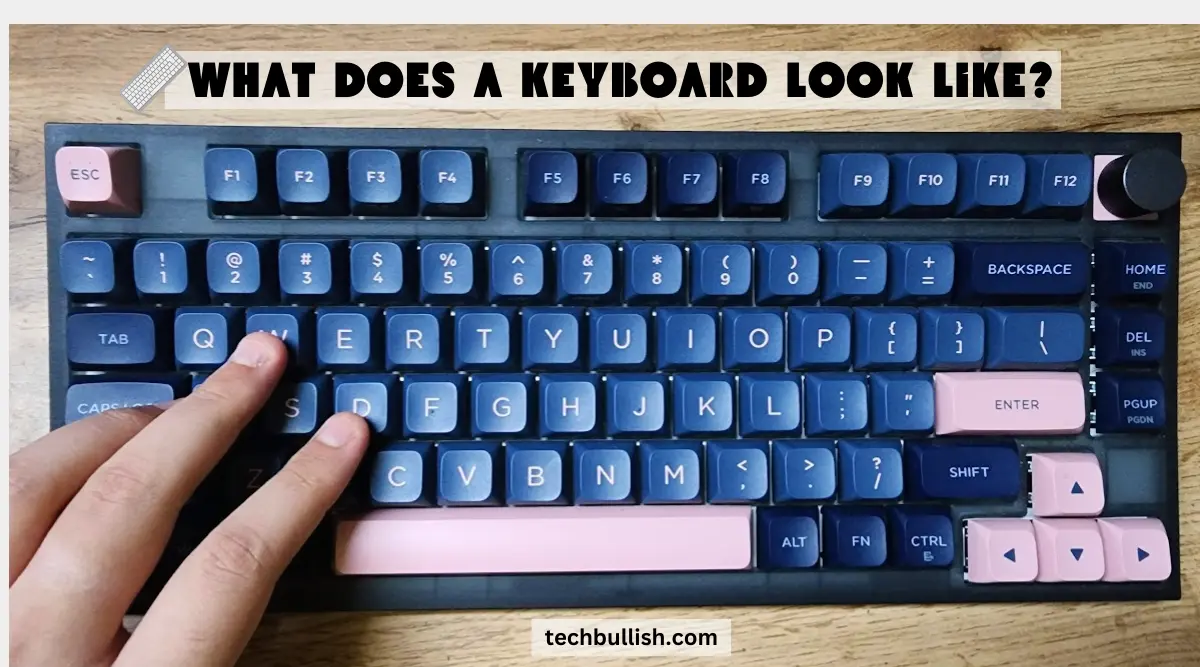If you are looking to know what a computer keyboard looks like, then you are at the right place. In this post, find a comprehensive guide to this and also learn about how to use the keyboard.

So, Let’s get started!
What Does A Keyboard Look Like?
A computer keyboard looks similar to a typewriter. They have a set of 104 or 105 keys(in the case of full-sized), which can be pressed to enter data into a computer. The shape and size of the keys on the keyboard vary from model to model, but all keyboards contain the same basic layout. The keys are laid in a grid pattern. Some keyboards also have additional keys, such as function keys, arrow keys, and a numeric keypad. There are also specialized keyboards, such as gaming keyboards or ergonomic keyboards, which are designed for specific purposes. To learn more about wkl keyboards, it is important to research the different types and their features to find the best fit for your needs.
Whether it is a Mechanical keyboard or a membrane keyboard, its basic form factor looks much similar.
A standard keyboard will typically have a full set of keys covering letters, numbers, symbols, and navigation. The main body is usually arranged in rectangular or square form and contains the majority of the keys used for typing.
It is usually broken up into four main sections:
- Alphanumeric keys (which include numbers and punctuation),
- Function keys (which provide shortcuts for various commands),
- Cursor control keys (for navigating documents and websites), and
- Special purpose keys such as volume control buttons.
They include an alphanumeric keypad on the left side and several function keys, such as F1-F12, along the top.
On PC keyboards there is also usually a Windows key or Command key located near the Spacebar. On Mac keyboards, there is also often an Option and Control key located near the Spacebar.
In addition to these standard keys, most modern keyboards also feature additional keys for multimedia functions or program shortcuts or even backlighting options for visibility in low-light conditions. These include backlighting controls, volume control buttons, calculator shortcut buttons, and more.
Standard Full Sized keyboards also come with a numeric keypad on the right side which can be used for data entry or for playing games that require numerical input.
Furthermore, some gaming keyboards come with extra macro and shortcut keys to help perform various game commands quickly and efficiently without having to type them out manually each time.
Most keyboards will also have a set of arrow and navigation keys located near the center at the bottom edge, along with “Enter” and “Escape” keys for executing certain commands.
Most standard keyboards use a USB connector to connect to your computer, but wireless models (which use radio frequency technology) are also available.
Other than these are typically sets of alphanumeric letters, numbers, and punctuation marks arranged in a traditional QWERTY format.
The left side of this section contains all other symbols and modifiers such as shift, backspace/delete, alt/option/command (depending on machine type) along with specialized characters found in various languages and scripts.
Finally, there are often additional special-purpose controls such as “Home,” “End,” “Page Up”/”Page Down,” etc., which can be used to navigate around documents or webpages quickly without using mouse input.
Now, the design of the keyboards depends on the:
- Keyboard Layout: Whether you use a QWERTY keyboard, Colemak or Dvorak layout keyboard decides your keyboard’s look. Also, whether your keyboard uses ANSI or ISO layout matters too.
- Keyboard Size: Even the size of the keyboard would decide because the number of keys and types of keys would depend on that.
- Even the History of Keyboards influences how it looks. Previously there were typewriters before computers came and keyboards arrive.
Keyboard Ports
A keyboard typically has a variety of ports and connections that allow it to be connected to a computer, laptop, or other devices. The most common type of port found on keyboards is the USB port.
This allows users to plug in their keyboard and have it recognized by the computer almost immediately. Some keyboards also have PS/2 ports for older computers which require an adapter for use with newer computers.
Additionally, some gaming keyboards may feature additional ports such as headphones and microphone jacks so gamers can communicate with each other while playing.
Wireless keyboards rely on wireless technology such as Bluetooth or RF (Radio frequency) to connect with devices without the need for any cables or cords.
Finally, some ergonomic keyboards come equipped with wrist rests which are designed to reduce hand and wrist strain while typing.
How to Use a Computer Keyboard?
Using a keyboard is an essential skill that is required for almost every computer-related task. The following steps will help you to learn how to use a keyboard effectively:
Step 1: Familiarize Yourself with the Keyboard Layout
Before you start using a keyboard, you need to familiarize yourself with the keyboard layout. A standard keyboard has 104 keys, including letters, numbers, punctuation, and special keys such as the function keys (F1 to F12), arrow keys, and control keys. Take a few minutes to study the keyboard layout, so that you know where each key is located.
Step 2: Sitting Posture
Having the right sitting posture while using the keyboard is important. Here are some tips:
- Sit up straight and avoid slouching
- Keep your feet flat on the floor
- Position your keyboard at a comfortable height
- Keep your arms and elbows close to your body
- Relax your shoulders
Step 3: Typing Technique
Typing technique refers to how you use your fingers to type on the keyboard. Here are some tips to help you improve your typing technique:
- Use all ten fingers when typing
- Place your fingers on the home row keys (ASDF for the left hand and JKL; for the right hand)
- Use your thumb to press the space bar
- Press each key gently and release it immediately
- Use the correct finger for each key
- Avoid looking at the keyboard while typing
Step 4: Keyboard Shortcuts
Keyboard shortcuts are a combination of keys that perform a specific task. Here are some commonly used keyboard shortcuts:
- Ctrl + C: Copy
- Ctrl + X: Cut
- Ctrl + V: Paste
- Ctrl + Z: Undo
- Ctrl + A: Select all
- Ctrl + S: Save
Step 5: Practice, Practice, Practice
The more you practice using the keyboard, the better you will become. Here are some ways to practice:
- Type out simple sentences or paragraphs
- Take an online typing course
- Use typing games to improve your skills
With regular practice, you can become proficient in using the keyboard and perform tasks more efficiently.
Conclusion
Let’s conclude the post on What does a Keyboard Look Like!
Now, I hope you got familiar with the keyboard after reading this post.

I’m Anirban Saha, Founder & Editor of TechBullish. With a B.Tech in Electronics and Communication Engineering, and 6+ years of experience as a software developer, I have expertise in electronics, software development, gadgets, and computer peripherals. I love sharing my knowledge through informational articles, how-to guides, and troubleshooting tips for Peripherals, Smart TVs, Streaming Solutions, and more here. Check Anirban’s Crunchbase Profile here.
